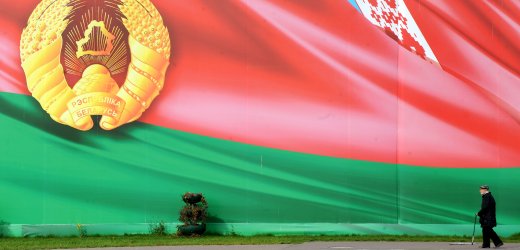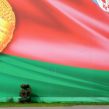
Belarus: Geopolitical Preferences and Realities of Foreign Relations
Publication: Eurasia Daily Monitor Volume: 10 Issue: 68
By:

Geopolitics remains the most common angle from which Belarus is looked at, not only by the analysts from Russia and the West but also by domestic commentators. A case in point is the national survey-based report by the Belarusian Institute for Strategic Studies (BISS), a Minsk-based think tank funded by the West, under the title “Geopolitical preferences of Belarusians: A Too Pragmatic Nation,” released on April 2 (https://belinstitute.eu/ru/node/847; https://belinstitute.eu/sites/biss.newmediahost.info/files/attached-files/BISS_SA07_2013ru.pdf).
According to the report, 70 percent of Belarusians find it acceptable to merge their country into a single state with Russia if this would improve the economic situation. In 2010, the respective share even amounted to 82 percent of the respondents polled by the BISS. It is hard to imagine any other state whose citizens would register this mass willingness to lose statehood in exchange for economic improvement. Jamestown Senior Fellow Vladimir Socor’s observation that the existence of Belarus’s statehood is “almost a miracle” (https://www.svaboda.org/content/article/24933165.html) hits the mark indeed. This willingness to join another country dovetails with the Warsaw-based Belarusian Analytical Workroom’s observation that Belarusian nationalism is “state-orientated, not culture-orientated” (Issue No. 7, March 2013). In Belarus’s political divide, it is the opposition that emphasizes cultural nationalism whereas the officialdom emphasizes nationalism of a civic type—i.e., deriving from common experience obtained in one and the same state. Therefore, ostracizing Belarusian officials and communicating predominantly with the opposition is not a smart policy because it is out of line with the actual (not theorized) Belarusian identity.
According to the same BISS report, 73 percent of Belarusians claim that economic motives should stand behind the choice of Belarus’s allies. Compared with that, considerations of strengthening democracy, retention of national uniqueness, and even fostering security do not seem to be significant when choosing the country’s allies. Only 7.3, 6.3 and 10.6 percent of respondents, respectively, admitted that such considerations should matter. Also, 30.9 percent of Belarusians prefer that Belarus stay away from any integration project whatsoever, whereas 17 percent of the population is in favor of European integration, and 23.3 percent support integration with Russia.
When faced with the rigid (either-or) choice between two integration projects, Russia’s and the European Union’s, 46.1 percent of Belarusians would opt for Russia and 28.1 percent for the EU. Fifty-seven percent of Belarusians believe that selling the largest Belarusian enterprises to European buyers is inappropriate, and 50.5 percent believe the same with regard to Russian buyers. Those in favor of integrating Belarus into European structures tend to be younger than those in favor of integration with Russia. Grodno and Vitebsk are somewhat geopolitical antipodes: Whereas in Vitebsk, the share of those in favor of a union with Russia is above the Belarusian average (20 percent versus 12 percent), in Grodno, the share of those favoring integration into the European structures is above average (20 percent versus 15 percent). This difference is in line with the cultural divide that, according to political scientist Samuel Huntington in his book Clash of Civilizations, runs across Belarus. Among the residents of Minsk, there is a heightened share (35.5 percent) of those believing that Belarus can be part of both Eastern and Western integration projects. About half of all Belarusians are not informed about EU sanctions against Belarusian authorities. Out of those who are, 40.1 percent believe that the reason behind them is that Belarus conducts an independent policy, and 13.4 percent believe that the EU is interested in regime change in Belarus. Still, 36.8 percent of those in the know believe that human rights are being violated in Belarus. Eighty-six percent of Belarusians have never heard of the EU Eastern Partnership project, and 95 percent of Belarusians have never heard about the “European dialogue on Belarus’s modernization” program.
Though apparently not generating much publicity, some attempts to boost Belarus’s ties with the West are still being undertaken. Thus, on March 26–27, Sergei Rachkov, in charge of the Belarusian Ministry of Foreign Affairs’ Department of the United States and Canada, visited Washington and had talks at the State Department and the US Congress (https://mfa.gov.by/press/news_mfa/b9bf15572648339c.html). Also, a North Atlantic Treaty Organization (NATO) delegation visited Minsk during April 2–5. The visit was in line with the individual program for partnership and cooperation between Belarus and NATO for 2012–2013. The delegation included representatives of the International Secretariat of NATO, the Allied Command Transformation, and the Allied Command Operations (https://www.mod.mil.by/news1.html#100).
Nevertheless, as is often the case, events and processes on Belarus’s eastern flank tend to be more vital for that country. For example, on April 4, Russian President Vladimir Putin suggested that Gazprom build a second Yamal-Europe natural gas pipeline across Belarus (news.tut.by/economics/342343.html). In the past, the Kremlin frequently touted the Baltic and Black Sea connections—that is, the already available Nord Stream as well as the South Stream pipeline, which is under construction—as alternatives to using Belarusian and Ukrainian transit routes. Now that Belarus’s transit networks are fully owned by Russia, Putin’s idea to add to the existing landlines is seen as a means of pressuring Ukraine into the Kremlin’s reintegration project, the Eurasian Economic Community. This is because the proposed Yamal-Europe Two pipeline may undercut the role of the Ukrainian gas transit and boost the role of the Belarusian one (see EDM, April 5, 10).
Belarus is, obviously, connected to Russia in many ways, one of which is labor migration. A realistic assessment of the scale of this migration has also been undertaken by BISS. Russia accounts for between 70 and 90 percent of temporary labor migrants from Belarus. At the time of the Belarus’s 2009 Census, 37,676 Belarusians worked in Russia. The current number of labor migrants is most probably between 200,000 and 300,000. (https://naviny.by/rubrics/society/2013/04/05/ic_articles_116_181355/).
In summary, more than ever since the breakup of the Soviet Union, Belarus is integral to the Russian-centered Eurasian reintegration project. It is unclear to what extent sober-minded and creative Belarus policies pursued by the West might mitigate a stark imbalance in Belarus’s foreign relations. But this may remain an open question unless such policies are eventually given a try.




